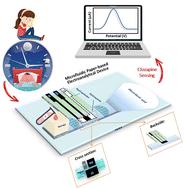Our official English website, www.x-mol.net, welcomes your
feedback! (Note: you will need to create a separate account there.)
Screen printed 3D microfluidic paper-based and modifier-free electroanalytical device for clozapine sensing
Analyst ( IF 3.6 ) Pub Date : 2024-10-04 , DOI: 10.1039/d4an01136h Mohammad Hossein Ghanbari, Markus Biesalski, Oliver Friedrich, Bastian J. M. Etzold
Analyst ( IF 3.6 ) Pub Date : 2024-10-04 , DOI: 10.1039/d4an01136h Mohammad Hossein Ghanbari, Markus Biesalski, Oliver Friedrich, Bastian J. M. Etzold

|
The increasing demand in healthcare for accessible and cost-effective analytical tools is driving the development of reliable platforms to the customization of therapy according to individual patient drug serum levels, e.g. of anti-psychotics in schizophrenia. A modifier-free microfluidic paper-based electroanalytical device (μPED) holds promise as a portable, sensitive, and affordable solution. While many studies focus on the working electrode catalysts, improvements by engineering aspects e.g. of the electrode arrangement are less reported. In our study, we demonstrate the enhanced capabilities of the 3D electrode layout of μPED compared to 2D μPED arrangements. We especially show that screen printing can be employed to prepare 3D μPEDs. We conducted a comparison of different 2D and 3D electrode arrangements utilizing cyclic voltammetry in [Fe(CN)6]3−/4−, along with square-wave voltammetry for clozapine (CLZ) sensing. Our findings reveal that the utilization of the 3D μPED leads to an increase in both the electrochemically active surface area and the electron transfer rate. Consequently, this enhancement contributes to improve sensitivity in the CLZ sensing. The 3D μPED clearly outperforms the 2D μPED arrangement in terms of signal strength. With the 3D μPED under the optimized conditions, a linear dose–response for a concentration range from 7.0 to 100 μM was achieved. The limit of detection and sensitivity was determined to be 1.47 μM and 1.69 μA μM−1 cm−2, respectively. This evaluation is conducted in the context of detection and determination of CLZ in a human blood serum sample. These findings underscore the potential of the 3D μPED for future applications in pharmacokinetic analyses and clinical tests to personalize the management of schizophrenia.
中文翻译:

用于氯氮平传感的丝网印刷 3D 微流体纸基无改性剂电分析装置
医疗保健领域对可访问且具有成本效益的分析工具的需求不断增长,这推动了可靠平台的开发,以根据个体患者的药物血清水平定制治疗,例如精神分裂症中的抗精神病药物。无修饰剂的微流体纸基电分析设备 (μPED) 有望成为一种便携、灵敏且经济实惠的解决方案。虽然许多研究都集中在工作电极催化剂上,但工程方面的改进(例如电极布置)的报道较少。在我们的研究中,我们展示了与 2D μPED 排列相比,μPED 的 3D 电极布局具有增强的能力。我们特别表明,丝网印刷可用于制备 3D μPED。我们利用 [Fe(CN)6]3−/4− 中的循环伏安法以及用于氯氮平 (CLZ) 传感的方波伏安法对不同的 2D 和 3D 电极排列进行了比较。我们的研究结果表明,利用 3D μPED 导致电化学活性表面积和电子转移速率的增加。因此,这种增强有助于提高 CLZ 传感的灵敏度。3D μPED 在信号强度方面明显优于 2D μPED 排列。在优化条件下使用 3D μPED,实现了 7.0 至 100 μM 浓度范围内的线性剂量-反应。检测限和灵敏度分别为 1.47 μM 和 1.69 μA μM-1 cm-2。该评估是在检测和测定人血清样本中 CLZ 的背景下进行的。 这些发现强调了 3D μPED 未来在药代动力学分析和临床试验中应用的潜力,以个性化精神分裂症的管理。
更新日期:2024-10-08
中文翻译:

用于氯氮平传感的丝网印刷 3D 微流体纸基无改性剂电分析装置
医疗保健领域对可访问且具有成本效益的分析工具的需求不断增长,这推动了可靠平台的开发,以根据个体患者的药物血清水平定制治疗,例如精神分裂症中的抗精神病药物。无修饰剂的微流体纸基电分析设备 (μPED) 有望成为一种便携、灵敏且经济实惠的解决方案。虽然许多研究都集中在工作电极催化剂上,但工程方面的改进(例如电极布置)的报道较少。在我们的研究中,我们展示了与 2D μPED 排列相比,μPED 的 3D 电极布局具有增强的能力。我们特别表明,丝网印刷可用于制备 3D μPED。我们利用 [Fe(CN)6]3−/4− 中的循环伏安法以及用于氯氮平 (CLZ) 传感的方波伏安法对不同的 2D 和 3D 电极排列进行了比较。我们的研究结果表明,利用 3D μPED 导致电化学活性表面积和电子转移速率的增加。因此,这种增强有助于提高 CLZ 传感的灵敏度。3D μPED 在信号强度方面明显优于 2D μPED 排列。在优化条件下使用 3D μPED,实现了 7.0 至 100 μM 浓度范围内的线性剂量-反应。检测限和灵敏度分别为 1.47 μM 和 1.69 μA μM-1 cm-2。该评估是在检测和测定人血清样本中 CLZ 的背景下进行的。 这些发现强调了 3D μPED 未来在药代动力学分析和临床试验中应用的潜力,以个性化精神分裂症的管理。

































 京公网安备 11010802027423号
京公网安备 11010802027423号